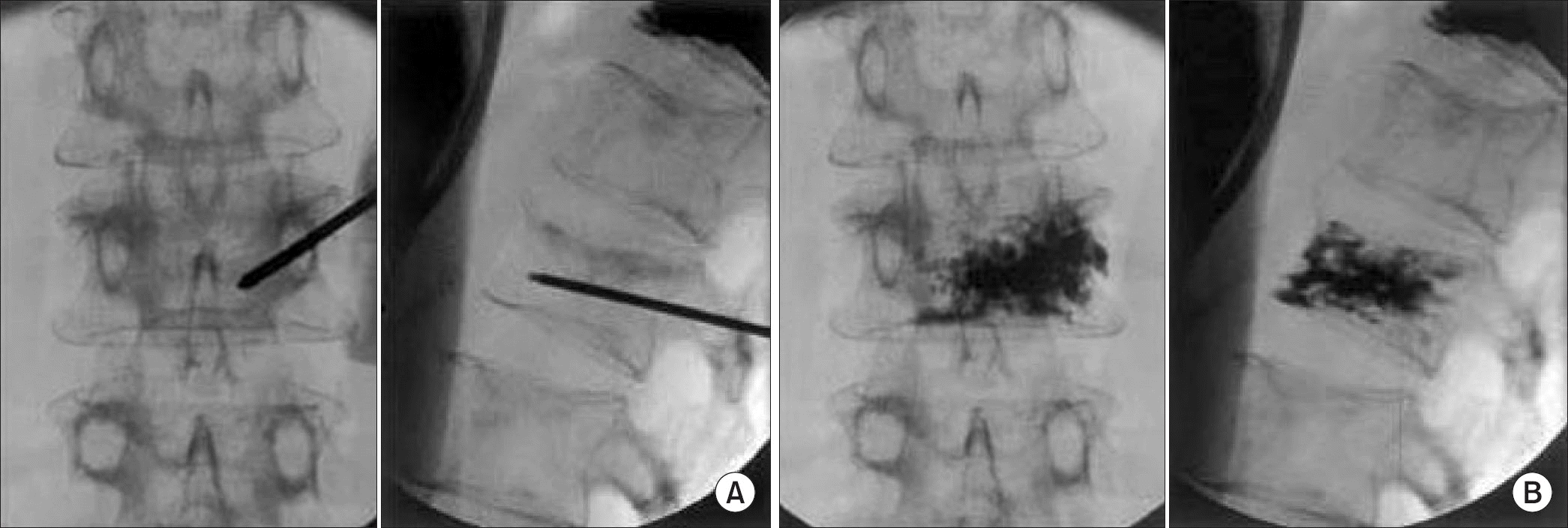Abstract
Purpose:
This study evaluated the efficacy of blood mixed cement for osteoporotic vertebral compression fractures in reducing the complications of percutaneous vertebroplasty using conventional cement.
Materials and Methods:
This study was performed retrospectively in 80 patients, from January 2016 to January 2017. Porous cement was formed by mixing 2, 4, and 6 ml of blood with 20 g of cement used previously. A tube with a diameter and length of 2.8 mm and 215 mm, respectively, was used and the polymerization temperature, setting time, and optimal passing-time were measured and compared with those using only conventional cement. Radiologically, the results were evaluated and compared.
Results:
The polymerization temperature was 70.3°C, 55.3°C, 52.7°C, and 45.5°C in the conventional cement (R), 2 ml (B2), 4 ml (B4), and 6 ml (B6), respectively, and the corresponding setting time decreased from 960 seconds (R) to 558 seconds (B2), 533 seconds (B4), and 500 seconds (B6). The optimal passing-time was 45 seconds (B2), 60 seconds (B4), and 78 seconds (B6) at 73 seconds (R), respectively and as the amount of blood increased, it was similar to the cement passing-time. The radiological results showed that the height restoration rates and the vertebral subsidence rates similar among the groups. Two cases of adjacent vertebral compression fractures in the R group and one in the B2 and B4 groups were encountered, and the leakage rate of the cement was approximately two times higher than that in the conventional cement group.
Conclusion:
In conventional percutaneous vertebroplasty, the procedure of using autologous blood with cement decreased the polymerization temperature, reduced the setting time, and the incidence of cement leakage was low. These properties may contribute to more favorable mechanical properties that can reduce the complications compared to conventional cements alone.
References
1. Kado DM, Lui LY, Ensrud KE, Fink HA, Karlamangla AS, Cummings SR; Study of Osteoporotic Fractures. Hyperky-phosis predicts mortality independent of vertebral osteoporosis in older women. Ann Intern Med. 2009. 150:681–7.

2. Bliuc D, Nguyen ND, Milch VE, Nguyen TV, Eisman JA, Center JR. Mortality risk associated with low-trauma osteoporotic fracture and subsequent fracture in men and women. JAMA. 2009. 301:513–21.

3. Rohlmann A, Zander T, Jony, Weber U, Bergmann G. Effect of vertebral body stiffness before and after vertebroplasty on intradiscal pressure. Biomed Tech (Berl). 2005. 50:148–52.
4. Teng MM, Cheng H, Ho DM, Chang CY. Intraspinal leakage of bone cement after vertebroplasty: a report of 3 cases. AJNR Am J Neuroradiol. 2006. 27:224–9.
5. Frankel BM, Monroe T, Wang C. Percutaneous vertebral augmentation: an elevation in adjacent-level fracture risk in kyphoplasty as compared with vertebroplasty. Spine J. 2007. 7:575–82.

6. Rohlmann A, Zander T, Bergmann G. Spinal loads after osteoporotic vertebral fractures treated by vertebroplasty or kyphoplasty. Eur Spine J. 2006. 15:1255–64.

7. Chen JK, Lee HM, Shih JT, Hung ST. Combined extraforam-inal and intradiscal cement leakage following percutaneous vertebroplasty. Spine (Phila Pa 1976). 2007. 32:E358–62.

8. Lim SH, Kim H, Kim HK, Baek MJ. Multiple cardiac perforations and pulmonary embolism caused by cement leakage after percutaneous vertebroplasty. Eur J Cardiothorac Surg. 2008. 33:510–2.

9. Lin EP, Ekholm S, Hiwatashi A, Westesson PL. Vertebroplasty: cement leakage into the disc increases the risk of new fracture of adjacent vertebral body. AJNR Am J Neuroradiol. 2004. 25:175–80.
10. Belkoff SM, Sanders JC, Jasper LE. The effect of the monomer-to-powder ratio on the material properties of acrylic bone cement. J Biomed Mater Res. 2002. 63:396–9.

11. Boger A, Bohner M, Heini P, Verrier S, Schneider E. Properties of an injectable low modulus PMMA bone cement for osteoporotic bone. J Biomed Mater Res B Appl Biomater. 2008. 86:474–82.

12. Loeffel M, Ferguson SJ, Nolte LP, Kowal JH. Vertebroplasty: experimental characterization of polymethylmethacrylate bone cement spreading as a function of viscosity, bone porosity, and flow rate. Spine (Phila Pa 1976). 2008. 33:1352–9.
13. Lin WC, Lee YC, Lee CH. . Refractures in cemented vertebrae after percutaneous vertebroplasty: a retrospective analysis. Eur Spine J. 2008. 17:592–9.

14. Tomita S, Molloy S, Jasper LE, Abe M, Belkoff SM. Biomechanical comparison of kyphoplasty with different bone cements. Spine (Phila Pa 1976). 2004. 29:1203–7.

15. Molloy S, Mathis JM, Belkoff SM. The effect of vertebral body percentage fill on mechanical behavior during percutaneous vertebroplasty. Spine (Phila Pa 1976). 2003. 28:1549–54.

16. Belkoff SM, Mathis JM, Jasper LE, Deramond H. An ex vivo biomechanical evaluation of a hydroxyapatite cement for use with vertebroplasty. Spine (Phila Pa 1976). 2001. 26:1542–6.

17. Gravius S, Kraska N, Maus U, Mumme T, Berdel P, Weisskopf M. Intravertebral pressure during vertebroplasty - an in-vitro study. Z Orthop Unfall. 2009. 147:43–7.
18. Baroud G, Crookshank M, Bohner M. High-viscosity cement significantly enhances uniformity of cement filling in vertebroplasty: an experimental model and study on cement leakage. Spine (Phila Pa 1976). 2006. 31:2562–8.

19. Ahn DK, Choi DJ, Lee S, Kim KS, Kim TW, Chun TH. Spinal cord injury caused by bone cement after percutaneous vertebroplasty: one case of long-term follow-up and the result of delayed removal. J Korean Orthop Assoc. 2009. 44:386–90.
Figure 1.
Percutaneous vertebroplasty. (A) Needle injection into vertebral body. (B) After cement injection into the vertebra.

Table 1.
Comparison of Blood Mixed Cement with Conventional Cement according to Blood Volume




 PDF
PDF ePub
ePub Citation
Citation Print
Print


 XML Download
XML Download